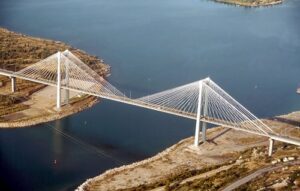Geographical & Historical Outline of Evia
Evia is the second largest of the Greek islands after Crete and is usually not thought of as an island at all, but as an extension of the main land.
Indeed its terrain and countryside are very similar to those of central Greece.
Opposite, while the gulf of Evia that separates them might be compared with a wide river, its two banks connected by the large bridge of Chalkida.
The island is linked with the mainland by many sea-crossings: Glyfa, Agios Konstantinos, Arkitsa, Oropos, Agia Marina and Rafina.
Evia has an area of 3.658 square kilometers, 15.180 long and from 7 to 45 kilometers wide, and has 677 kilometers of coastline.
It is divided into three parts: North, Central and South Evia.
North Evia has low mountains and hills and a large plain reaching down to the sea.
Central Evia is mountainous, the highest peak being mount Dirphi (1.743 meters).
South Evia is generally flat, the highest being mount Ochi.
The island has a number of small rivers and mineral springs.
Geographical & Historical Outline of Evia
HISTORY
In ancient times it was called Makrys, Doliche and Ellopia and was inhabited from the late Neolithic period.
The ancient Euboeans sent a contingent of 40 ships to the Trojan War.
In the 8th century BC Euboea was at the height of its prosperity and influence, and its major cities, Chalkis and Eretria founded colonies in Western Greece, South Italy and Sicily.
In the 5th century BC, it was subjected to the power of the Athenians and was later conquered by the Macedonians.
In 146 BC it was incorporated into the Roman State.
Under the Byzantine Empire, the island belonged to the theme of Greece with its capital at Chalkis.
In 1205 it was captured by the Franks and from 1470 to 1833 was subjected to the Turks.
At the end of the 17th century, the Venetians unsuccessfully laid siege to Chalkis.
The island took part in the Greek War of Independence against the Turks in 1821, and Evia was annexed to the newly created Greek State in 1833.


